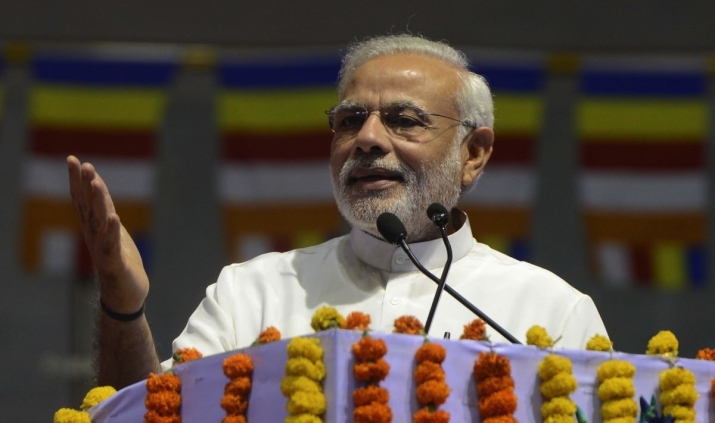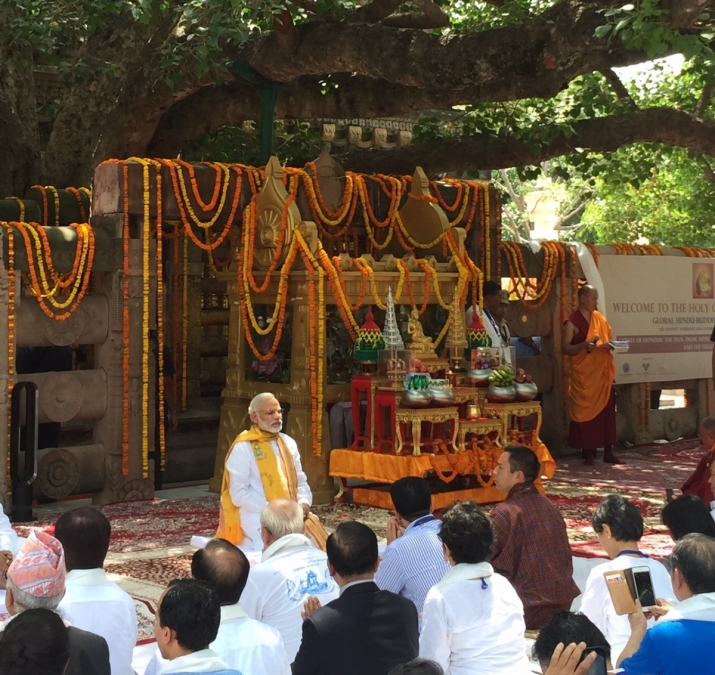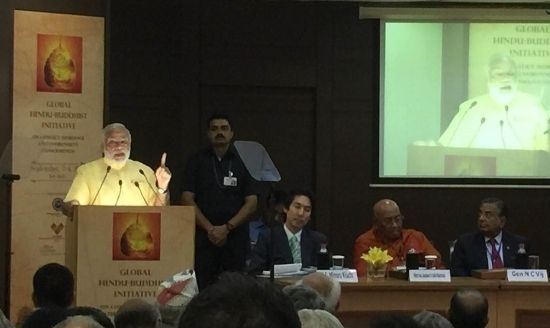FEATURES|THEMES|Commentary
Buddhistdoor View: India’s Buddhist Diplomacy
 Narendra Modi gives a speech in front of a backdrop of Buddhist flags in New Delhi on Buddha Purnima, 4 May 2015. From IANS
Narendra Modi gives a speech in front of a backdrop of Buddhist flags in New Delhi on Buddha Purnima, 4 May 2015. From IANSIndian prime minister Narendra Modi has been making waves among commentators, analysts, and Buddhism watchers for his unusually active incorporation of Buddhism into his cultural diplomacy. In May, he embarked on a closely observed trip to China, posing with Chinese president Xi Jinping at Giant Wild Goose Pagoda and Daxingshan Temple, symbolic and spiritual epicenters of the Buddhist Silk Road. He was also the chief guest at the recent conference “Samvad—A Global Hindu-Buddhist Initiative on Conflict Avoidance and Environment Consciousness,” held in New Delhi and Bodh Gaya from 3–4 September. This conference, organized by the Vivekananda International Foundation in association with the Tokyo Foundation and International Buddhist Confederation, is only one component of a purported “Hindu-Buddhist thrust” that Modi is balancing delicately with his preoccupation with China (some Chinese delegates were invited but did not attend).
At the conference, Modi, with his typically charismatic flair, declared that India was “taking the lead in promoting the Buddhist heritage across Asia.” His courting of the initiative's Buddhist representatives culminated in a private visit to a Bodh Gaya bristling with elite security forces on the 5th. Here, the Samvad delegates were present to see him execute a public relations master stroke of “reclaiming” Buddhism by sitting and meditating under the Bodhi Tree of the Mahabodhi Temple, a statement clearly intended to surpass the symbolic power of Jawaharlal Nehru's visit in 1953. He is playing the Buddhism card on different fronts, hoping to position India as a culturally invaluable connector between Asian countries, even if those countries see each other as geopolitical rivals.
In May, Modi made the unprecedented move of making Buddha Purnima an official holiday to be celebrated each year, a politically astute move intended for both domestic and international consumption. Now, according to The Telegraph India, he is taking the Buddhist emphasis in diplomacy even further. The paper reported in a comprehensive article on 30 August that the government plans a “blitzkrieg of novel projects” designed to reach out to the entirety of Asia, but with a particular focus on East Asia. These include conferences with policymakers, academics, and monks, and visits by prominent Buddhist masters to Indian sites, all under the watchful eye of the Foreign Office’s branch for cultural diplomacy, the Indian Council for Cultural Relations.
The passion and urgency with which Modi is pushing Buddhism as a core rubric of cultural diplomacy or, put more assertively, Indian soft power, seems disproportionate given how few people in India are actually Buddhist: around 0.7 per cent of the population in the 2011 census (a decline from the 0.8 per cent recorded in the 2001 census). However, even the most insightful and worthwhile conferences and seminars often preach to the converted or among similar circles of bureaucrats, scholars, religious figures, and journalists. Nor will it be enough to invoke Buddhism simply to appeal to the neo-Buddhist Dalit community. If he really believes in the diplomatic and domestic benefits of Buddhism, Modi needs to go beyond political and academic engagement (at which he is doing very well) and be open to a future change in the composition of the religious demographics of Indian society.
Narendra Modi speaks at the recent conference “Samvad—A Global Hindu-Buddhist
Initiative on Conflict Avoidance and Environment Consciousness.” From
Buddhistdoor Global
Internationally, Modi’s intentions are pragmatic as well as nostalgic: since India is looking eastwards to the economic powerhouses of China, Japan, South Korea, and Taiwan, he has discerned the need to offer a relationship that runs deeper than the hunger for trade or GDP growth. Only Buddhism can connect these vastly different countries with different allegiances and goals to a single spiritual source from 2,500 years ago. The domestic picture is quite different. Even though India hosts the Dalai Lama and one of the most important Tibetan communities in the world in Dharamsala, Buddhism wields effectively no internal weight, prestige, or consequence. Moreover, Modi leads a Hindu nationalist party, the Bharatiya Janata Party, which is not only the largest political party in India but also advocates the Hindutva ideology of revolutionary Vinayak Damodar Savarkar (1883–1966). Hindutva sees Hinduism as encompassing not only religious practice but cultural and social belonging. Savarkar argued for harmony amongst India’s diverse faiths, but it is difficult to reconcile his emphasis on loyalty to Hindu political and cultural identity with contemporary ideals of a pluralist political party.
Despite Modi’s vigorous promotion of Buddhism, it is unlikely that he has much domestic leeway to advocate for Buddhism as a living tradition. While there is no restriction on the propagation of Buddhism in India (freedom of religion is enshrined as a fundamental right in Articles 15 and 25 of the Indian constitution), in practice it has little to no voice in conservative Indian society and politics. It is understandable (even commendable in certain cases) that politicians seek to appropriate a religion for the purposes of peaceful diplomacy and cross-cultural understanding. However, if it is serious about encouraging Buddhism to be a significant social and political force in India, the Modi government must be open to negotiating a louder domestic voice for Buddhists, thereby enabling their numbers to grow.
Daya Thussu of the University of Westminster has already suggested in The Telegraph India that “investing in protecting and promoting Buddhist sites,” “encouraging study of Buddhist art, philosophy, and literature in Indian universities,” and “providing internationally acceptable infrastructure for faith-based tourism and scholarship” are the core activities that would benefit India’s soft diplomacy in the long term. These activities would also have the side effect of bringing a greater awareness to Indians about one of their country’s great ancient faiths, possibly even helping to develop Indian Buddhism over the next few decades. It is almost certain that the revival and spread of Buddhism among all social demographics (not just among specific groups like the urbanized middle class or the Ambedkar Dalits) is something that Modi is more or less indifferent to, if not totally against.
It would be reassuring to see the Modi government do three things. First, as Daya Thussu has mentioned, it should raise the standards of Buddhist Studies in India. In this regard, good progress is being made. Nava Nalanda Mahavihara in Bihar, which seeks to achieve a sense of historical continuity with the old super-monastery Nalanda as well as academic success in Buddhist Studies, is but one example. Others include Sanchi University of Buddhist-Indic Studies and Nalanda International University (distinct from Nava Nalanda Mahavihara), whose chancellor is former Singaporean politician George Yeo. Whether these institutions can shift the orbit of Buddhist Studies to India depends very much on infrastructure, facilities, and the quality of teaching.
Second, expanding on Thussu’s point about faith-based tourism infrastructure, the government should streamline bureaucracy and cut red tape for private firms and Buddhist non-profits that want to promote Buddhist sites and circuits or build new practice or tourism centers. One member of a Buddhist organization we spoke to complained that due to planning delays and restrictions, their center is essentially a collection of camp tents on a patch of land, and is still awaiting permission to put a roof over their heads.
 Narendra Modi sits under the Bodhi Tree at the Mahabodhi Temple, Bodh Gaya, on 5 September 2015. From Buddhistdoor Global
Narendra Modi sits under the Bodhi Tree at the Mahabodhi Temple, Bodh Gaya, on 5 September 2015. From Buddhistdoor GlobalFinally, and crucially, the Modi government should promote Buddhism as an integral future cultural and religious component of Indian civilization, not just as a valuable relic of the past that links India to other Asian nations. If domestic political constraints hold Modi back from promoting Buddhism within India, then all the more reason he should “outsource” this task to businesses and charities that are looking to gain from a revival of Buddhism in India, both through the “hardware” (preserving the archaeological sites, studying and stewarding Buddhist art, funding museums and facilities at Buddhist sites) and the “software” (tourism, conferences, and pilgrimages). There is no significant ethical argument against the private sector helping to develop the hardware and software, provided the means to the end stay ethical (such as enforcing fair wages, minimal environmental impact, and regular consultation with the Buddhist groups they collaborate with).
This political ambivalence of modern, largely Hindu, India with its Buddhist past is aptly symbolized by the Lion Capital of Sarnath, which is used as the Indian state emblem. It was first conceived by an emperor who, most Indian historians proudly note, converted to Buddhism after a transformation of conscience, yet was chosen to be post-British India’s emblem by nationalists who based their statecraft on Hindu identity. It is difficult not to conclude that Modi’s Buddhist diplomacy is similarly riddled with contradictions. However, it is in negotiating and working within these tensions that creative and impactful solutions can be found.
See more
Buddhistdoor View: Buddhism at the Heart of Sino-Indian Relations (Buddhistdoor Global)
Modi govt plans Buddhism blitz in cultural diplomacy refocus (The Telegraph India)
‘Hindu-Buddhist’ thrust in foreign policy likely soon (asianage.com)
Proportions of Hindu, Sikh & Buddhist population decline; those of Muslim go up by 0.8%: Census on religion (IBN Live)
The Future of Buddhism in India: An Interview with Dr. Ravindra Panth (Buddhistdoor Global)















